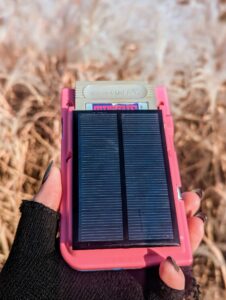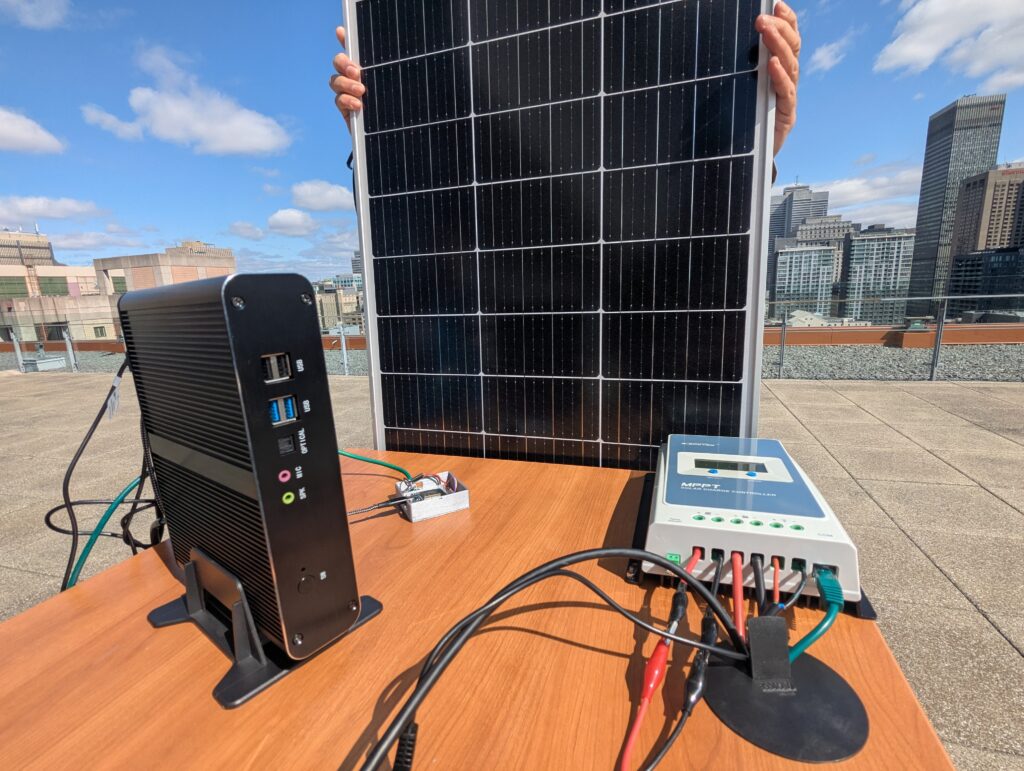The Origins of SunBlock One

The idea for SunBlock originally came to me a few years ago when I discovered The Solar Protocol project led by Tega Brain, Alex Nathanson and Benedetta Piantella.

Part online art installation, part tech demo and part community mobilization, the solar protocol is a network of solar powered webservers located around the world. As the introduction to the manifesto reads, “The Solar Protocol network reconfigures internet protocols using a kind of natural rather than artificial intelligence. The network routes internet traffic according to the logic of the sun, where page requests are sent to whichever server is enjoying the most sunlight at the time.” The project draws much from the low-tech movement and even the basic solar powered server design one can find in the Low-Tech webzine but what fascinated me most what the idea of pulling together a kind of community of practice around low power webservice complete with low-power fonts and image processing.

The only thing that bothered me about the project is that the practical use case seemed too limited, and low-tech world it imagined seemed too bleak. It is an important experiment, but despite adhering to principles of maximum accessibility I felt that it was just too utilitarian… almost too Protestant, even Lutheran 😊. I think the problem for me stems from low-tech computing’s bare instrumentalism and the very potent argument that we don’t need to have such a high environmental cost to do the computing we need to do. This makes sense to me if we see computing as a tool but its not just a tool. Computing, for better or for worse, might be more like a toy than a tool and its not about what we need to do; its also about what we might desire to do.
So maybe let’s try to make a version of solar protocol centred on something useless, and at the same time why not try this with an online experience millions of people actively pursue… just for fun. Gaming! Why not try this with Minecraft.

There is already low power Minecraft. It is a version of the game available for the Raspberry Pi (Minecraft: Pi Edition). I toyed with this version extensively when I was first messing with Pis with my kids but it’s a woefully sad version of Minecraft, and to my mind nearly unplayable unless you have never played Minecraft before. The more you try to play the Pi Edition the more you’d rather boot up a PC or Console to play the “real” thing. Bit, what if we could make a solar protocol type network of Minecraft servers.
Even better, what if we could make such a network with modded Minecraft servers and do some serious gaming?
The proposition moves away from social imaginaries premised on energy minimalism and instead considers the problem in a more scalar form. Instead of low power computing maybe we should consider lower power computing and ask, how can we play state of the art Minecraft but use less energy? Could we imagine net-zero Minecraft? And even if we could, why should we care? We need to be able to transport goods and services from place to place so net-zero transportation is a real problem. We don’t actually NEED to play Minecraft. Will this project be a kind of green-washing distracting us from more pressing concerns of the climate crisis?

I had this in my head when I teamed up with Matt Ratto, Arno Verhoeven and Robert Sodden for the Photovoltaic Imaginaries Project which produced some amazing discussion that led to this speculative paper for the Computing within Limits conference. Around the same time, I got a small Concordia Sustainable Transitions Team Research Initiative grant which I used to help support projects for the student-organized Solar Media Collective. The solar media collective did a lot of impactful work that influenced my thinking, especially work by Alex Custodio, Michael Iantorno, Hanine El Mir on working with solar gameboys (published here).

Around the same time Kara Stone was working on Solar Server Games which also built with a low-tech permacomputing approach, and I was delving into the whole area of ecogames and sustainable computing that exploded with the formation of Playing for Planet Alliance in 2019 and the publication of Ben Abraham’s, Digital Games After Climate Change in 2022. I was thinking that Minecraft ecogaming could be about doing more than opting to build a simple dirt hut base, replanting trees, and avoiding mining.
The SunBlock project took shape in response to all this and rested on a simple premise. How could playing with solar power matter beyond the relatively insignificant impact it might have on global CO2 concentrations. There is no point playing games on a Raspberry Pi drawing 2 Watts when you can play the most resource intensive modpacks on a miniPC drawing around 20 Watts. The difference here is negligible. So, lets scale up our server and find the configuration that draws the least amount of power to play the games we really want to play, and more importantly, lets make that as inexpensive and DIY as possible so players can mess around with this space between the lowest possible carbon cost of computing and the highest. Let’s think about sustainable computing as a case modding challenge. Let’s make the sustainability of computing into a game mechanic.
Back in the day, I used to go to LAN parties where gamers would “race” their rigs… overclocking the CPU or GPU and pushing performance in dramatic displays augmented by liquid nitrogen (for cooling) or spontaneous fires. What if underclocking or undervolting could be just as dramatic and just as fun? How would a truly solarpunk PC build work as opposed to just how it would look?
Of course, SunBlock is just a server… we are not yet modding our PC client rigs (though we will), and we also know that is where the vast bulk of energy consumption in playing Minecraft occurs. But working with the server puts us on our way to thinking about how sustainable and less sustainable computing might matter to actual gameplay. How can we make the power consumption of the game hardware part of the experience of the game software? How do we let players not only see, but also play with what is going on under the hood?

We don’t actually need solar power to do this? We could collect energy data from any source and make it playable in modded Minecraft. The addition of our 100W solar panel, solar controller and battery takes us off-grid giving us a lot of control on the one hand (because we know exactly how much power we are producing, storing and using), and hardly any control on the other (because our gaming depends on the weather in Montreal). This uncertainty can be an amazing game mechanic, and at the same time it is object lesson in the technical, social and political aspects of renewable energy.
All these threads twisted around in our minds as we set to work building and testing SunBlock One and then developing our first mod, SunBlock Core, and finally our first game, Gaia’s Riddle. If you are intrigued about any of this and want a taste… or perhaps to collaborate then reach out to us to join our discord and come play Gaia’s Riddle on May 1.